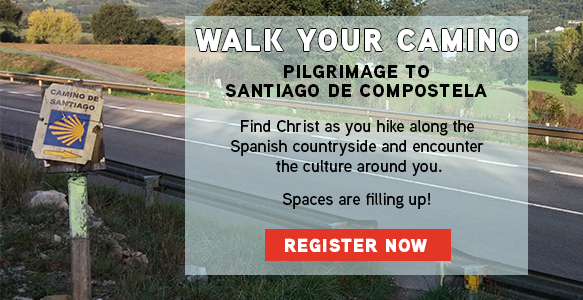Catholics around the globe share similar traditions during Holy Week—Stations of the Cross, Passion plays, and, of course, Holy Thursday and Good Friday services.
But in Spain, the words for Holy Week—Semana Santa—represent an entire tradition of its own.
It began as an effort by the Marqués de Tarifa to bring the tradition of the Stations of the Cross to Spain after visiting the Holy Land in 1521.
Through time, the simple tradition of meditating on the steps of Christ’s journey to the cross spilled out onto the streets of Spain in the form of processions with elaborate “floats” depicting the stations, statues of Mary, banners, candles and crosses.
The floats are not the temporary creations of a Mardi Gras parade—they are massive, heavy works of art (sometimes centuries old). Think of something akin to a 10-30-foot-long side altar made with solid, intricately carved wood and adorned with wooden or plaster statues, ivory, gold and heavy blankets of flowers thick as a carpet.
There are no motorized trailers carrying these “floats.” Rather, they’re borne by members of cofradias (confraternities or brotherhoods)—lay organizations dedicated to carrying out works of charity. Some floats require as many as 80 people bearing the weight of these stations, which can weigh more than 4,000 pounds.
Following along in the procession are other cofradia members dressed as penitentes, or penitents. Some walk barefoot or with shackles and chains on their feet. Many wear long robes or cloaks and a capirote—a hooded face covering with a long, conical point. Admittedly, a capriote looks like a Ku Klux Klan hood, but its meaning is completely different. The tall, conical tips represent a desire to be nearer to God and date to the 15th century as a sign of penitence.
Different regions of Spain, such as Andalusia, Castille and Leon, Murcia and Galicia, each have features that distinguish their Semana Santa processions from other areas. Some include bands, some march only to the beat of a drum, and some have no music at all. Some are meditative, while others are noisy with songs, cheers and applause.
Other countries settled by Spain carry on the Semana Santa tradition. In Central and South America, the Holy Week processions take place in Latino countries like Bolivia, Brazil, Ecuador, El Salvador, Guatemala, Honduras, Mexico and Paraguay.
Father John McCaslin, pastor of St. Monica Parish in Indianapolis, Ind., experienced Semana Santa while studying Spanish in Antigua, Guatemala.
For the Holy Week procession there, he says, “They have a beautiful tradition of constructing in the streets alfombras. Alfombras are carpets made from colored sawdust or natural things such as flower petals and pine needles. They are elaborate and ornate in their designs. Once constructed no one walks over them. Only those in the procession can walk over the alfombras, destroying their beauty as they process forward in faith.”
The procession Father McCaslin witnessed included “men dressed as Roman soldiers leading the procession. Following the soldiers were men dressed in purple outfits and someone carrying a thurible burning a local tree bark that smells amazing.
“Then there were 40 or 80 men carrying a large wooden platform with a sacred image of Jesus on it, such as during the carrying of the cross. This heavy float is carried on the shoulders of the men who walk with a cadent swing as they move forward.
“Behind that was a small band playing music. Following the band was a small float with an image of our Blessed Mother carried by women.
“The streets were packed with both people in the procession as well as people watching it pass by. There were also many street vendors selling various items and yummy food. It was a beautiful experience.”
The Semana Santa processions do more than offer a way of meditating on Christ’s Passion during Holy Week, says Father McCaslin. “They are a public expression of faith that captures our religious imagination. Children remember these experiences and want to share them with their children once they are adults. They are used to teach and recite prayers and to teach the faith.”
Many parishes with large Hispanic populations in the U.S. carry on the Semana Santa procession tradition, albeit on a smaller scale. Father McCaslin’s parish offers a procession on Good Friday.
“As sacramentals, everyone can participate, and it is a way to bring beautiful traditions from their places of origin into their new homes. Never having participated in processions when I grew up, I have come to love, value and appreciate them.”
For a short video of a Semana Santa procession in Spain, go to youtu.be/Ri7Fgx9UymA.


